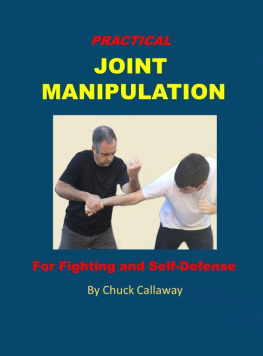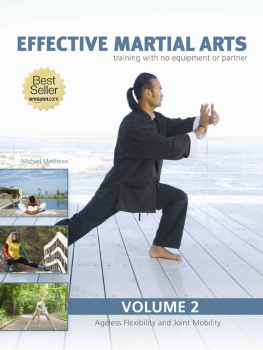Practical Joint Manipulation
For Fighting and Self-Defense
By
Chuck Callaway
Copyright 2020 Chuck Callaway
Cover and illustrations by Chuck Callaway
Photographs by Bryan Callaway
Technical assistance by Conner Callaway
All rights reserved.
ISBN: 9798578726842
Disclaimer and Warning
The martial arts and self-defense involve the use of fighting skills and techniques designed to cause injury to an attacker. The practice and use of these skills can be dangerous and physically demanding. The improper use of any fighting technique could result in both criminal and civil action against the person responsible. The information provided in this book is for informational and entertainment purposes only. The author and publisher are not responsible and assume no liability for any injury that might result from the practice, use, or misuse, of the information contained in this book. One should always consult a physician before engaging in any physical activity. The information contained in this book is intended to document fighting techniques, skills, principles, and theory as studied and taught by the author to a select few students. While a tremendous amount can be learned from these pages, it is impossible to convey specific movement, subtleties and to correct a students errors in written form. The reader should seek out a qualified instructor to ensure safe and proper study.
Contents
Special Thanks
To
Bruce Lee and Chuck Norris for inspiring a
young kid to learn martial arts in 1979.
Bigger Thanks
To
The all the Sifus, Senseis, and Gurus
that taught me my fighting skills.
Above allThanks
To
Those difficult people in life who forced me to
put my knowledge to the test and
made me stronger for it!
Introduction
W e often have moments of clarity or realization in life that shape our beliefs and change our future views. Although it has been over thirty years ago, I remember the day my thoughts on the use of joint manipulation for self-defense changed forever. It was early morning, and I was sitting in the bed of a military pickup truck waiting to be transported to my post. Other soldiers were getting their weapons from the armory and starting to climb into the truck around me. It was my lucky day because I had been the first in line to get my rifle and I had the best seat in the bed of the truck with my back against the cab for support. The ride to my post was long, but I would be comfortable. Thats when I heard him. Hey man, Im going to sit there, you need to move! I turned to see one of my fellow soldiers who I didnt know very well staring intensely at me. He immediately told me again that I needed to move because he wanted my seat in the truck. I politely responded that I was not going to move, but he insisted for a third time as he grabbed ahold of my wrist. Im going to yank your ass out of that truck, he said, and he began to aggressively pull on my arm. I tumbled out of the truck but managed to land on my feet and instinctively seized the arm he had grabbed me with. What happened next surprised us both. I was standing over the obnoxious soldier, who was now on the ground in an armbar. Without thinking, I had perfectly executed an outside wrist lock followed by a step across move and I had him under control on the ground. I released the hold and allowed him to get up. Others who were in the truck and standing around started laughing and making comments which infuriated him. He said, You want to fight? as he took off his web belt and gear. I said, no, I dont want to fight, and I got back in the truck which ended the incident. People would talk about what occurred that day for the remainder of my time in the military and the story eventually became exaggerated, but it was a moment of realization for me. I suddenly realized that the joint manipulation techniques I had been practicing for years in my martial arts training could be applied in a real situation against an aggressive opponent. Prior to this incident, I hadnt focused too much on joint manipulation skills in my training. I had been studying the martial arts since the late seventies, and had achieved black belt level, but I was always more into the striking and kicking techniques. While I knew some basic joint locks from my training, I never used them in sparring. This encounter caused me to re-evaluate that. Starting in 1987, I was lucky to study martial arts under Sifu Vic Butler. A significant portion of our training centered around joint manipulation techniques. Over the years I studied other martial arts that focused on joint manipulation such as Jiujitsu, Aikido, Kung-Fu, and Kali. My years of service as a police officer solidified my knowledge of joint manipulation techniques and further confirmed how effective they could be in real life encounters. Eventually, I became a defensive tactics instructor and taught joint locking skills to hundreds of police officers. The techniques in this book are the result of over forty years of martial arts, military, and police training. I know they are effective because I have used them on numerous occasions to subdue people who were resisting, control individuals who were trying to escape, and to protect myself against physical attacks. My goal is to provide you with a basic system of effective joint manipulation skills. I wont waste your time with fancy untested theories or moves. We will cover the key concepts, techniques, and training that you will need to effectively apply these skills in a real self-defense situation. I hope you enjoy the book.
Chuck Callaway
November 2020
Chapter
Myths and Realities
There are a lot of misconceptions and false assumptions in the martial arts world today when it comes to joint manipulation. On one hand, many practitioners believe that standing joint locks are useless. They think they are only for the movies and dont work in a real situation. Others believe they can be used to easily tie up multiple opponents like a pretzel or to flip an attacker through the air with ease. Obviously, both beliefs are wrong. The fact is that joint manipulation techniques are extremely effective and can be used to end a fight quickly if properly trained and applied. In this chapter we will identify what joint manipulation really is and when it should be used. We will also discuss some of the myths and realities surrounding its use.
What is Joint Manipulation?
The human body consists of numerous bones that connect throughout the skeletal system. The location where these bones meet are called joints. There are several types of joints that each have unique functions and ranges of movement. Joint manipulation is simply twisting and turning these joints in a manner that is contrary to their normal range of motion. When a joint is forced in a direction that it normally doesnt move, it becomes locked or immobilized. By locking and immobilizing an attackers joints, a fighter can control or disable an opponent in a fight. One of the benefits of joint manipulation is the ability to subdue or control an opponent without hurting them. On the other hand, a skilled joint manipulator can cause severe injury or render an opponent unconscious if the situation warrants it.
Types of Joints
All the techniques in this book will be applied to specific joints that fall into one of several different categories. Knowing how these joints operate is essential to understanding how to properly apply joint locking techniques. The four types of joints that are most commonly targeted for joint locking techniques are as follows.
Hinge Joint- Hinge joints are among the most common targets for joint locking techniques and include the elbows, knees, and finger joints. Think of these joints just like the hinges on a door. The normal range of motion for a hinge joint is from zero to around one hundred and sixty degrees. If the joint is manipulated beyond this range, it becomes locked or hyperextended. By hyperextending the opponents joint, we can temporarily immobilize him and control his movement. We will discuss hyperextension in more detail in a later chapter.









